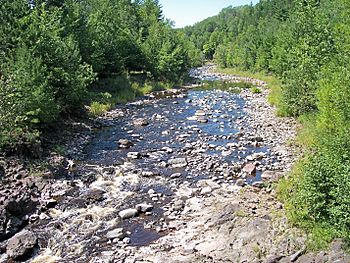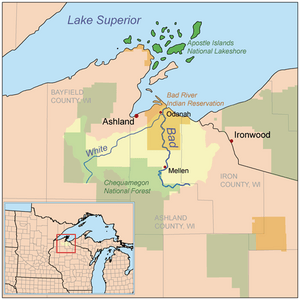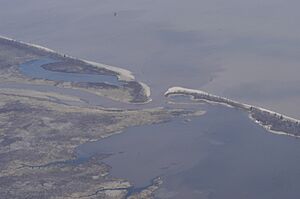Bad River (Wisconsin) facts for kids
Quick facts for kids Bad River |
|
|---|---|

The Bad River in Copper Falls State Park in 2006
|
|
 |
|
| Country | |
| State | |
| Physical characteristics | |
| Main source | Caroline Lake 1,522 ft (464 m) 46°16′05″N 90°33′40″W / 46.26806°N 90.56111°W |
| River mouth | Lake Superior Bad River Indian Reservation 600 ft (180 m) 46°38′17″N 90°39′09″W / 46.63806°N 90.65250°W |
| Length | 74.3 mi (119.6 km) |
| Basin features | |
| Basin size | 1,061 sq mi (2,750 km2) |
| Official name: Kakagon and Bad River Sloughs | |
| Designated: | 2 February 2012 |
| Reference #: | 2001 |
The Bad River is a river in northern Wisconsin, United States. It flows into Lake Superior, one of the Great Lakes. This river is about 74 miles (119 kilometers) long. It drains a large area of land, covering parts of Ashland, Bayfield, and Iron counties. The wetlands near the Bad River's mouth are very special. They are recognized internationally for their importance to nature.
Contents
Where Does the Bad River Flow?
The Bad River starts from the southwestern part of Caroline Lake. This lake is shallow and surrounded by spongy, wet lands called peatlands. The river first flows southwest. Then it turns north for most of its journey.
Places the River Passes Through
Along its way, the Bad River flows through several interesting places. It passes through the city of Mellen. It also goes through Copper Falls State Park. Finally, it reaches the community of Odanah. This community is part of the Bad River Indian Reservation.
River Features and Tributaries
Near Mellen, the riverbed is often rocky. You can see many boulders and fast-moving whitewater rapids. In Copper Falls State Park, the river creates beautiful waterfalls. It also carves its way through a narrow granite gorge.
Closer to Lake Superior, the river forms a delta. This delta helps create a huge area of wetlands. These wetlands are known as sloughs. They cover about 16,000 acres.
The Bad River has several smaller rivers flowing into it. These are called tributaries. The largest tributary is the White River. It joins the Bad River near its mouth. Other important tributaries include the Potato and Marengo rivers. The Tyler Forks joins at Copper Falls State Park. The Iron River flows into the Bad River upstream of Mellen.
Why Are the Bad River Wetlands Important?
The Kakagon and Bad River Sloughs are very special wetlands. They are listed under the Ramsar Convention. This is an international agreement to protect important wetlands. The Sloughs were added to this list on February 2, 2012. They cover about 4,355 hectares (10,760 acres).
What Makes These Wetlands Unique?
These wetlands are mostly untouched by human development. They include sloughs, bogs, and coastal lagoons. They are home to the largest natural wild rice beds in the Great Lakes region. These rice beds are vital for keeping different types of wild rice healthy. Local tribes still harvest this wild rice using traditional methods.
Animals Living in the Wetlands
Many animals live in these important wetlands. You might find rare mammals like the grey wolf and the Canada lynx. Lots of birds also live here or stop during their migrations. This includes the endangered piping plover.
Protecting the Wetlands
The wetlands face some challenges. Invasive species can harm the natural environment. Also, pollution from human activities nearby can be a threat. Protecting these areas helps keep the river and its wildlife healthy.
What Are the Bad River's Other Names?
The United States Board on Geographic Names officially decided on the name "Bad River" in 1965. However, this river has been known by other names throughout history.
Here are some of its historical names:
- Mashki-Sibi
- Maskesipi
- Maskigo
- Mushkeesebe
- Swamp River


